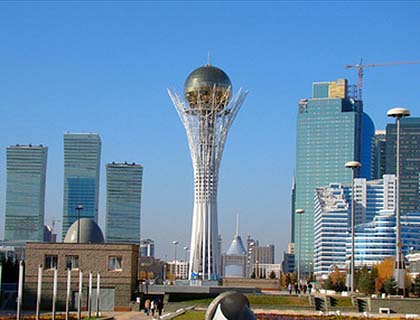Who said that "East is East, and West is West, and never the twain shall meet'? But there is a city in Kazakhstan that refuted these seemingly unbeatable words of Rudyard Kipling. In 1997 the President of sovereign Kazakhstan Nursultan Nazarbayev proposed to relocate the country's capital from Almaty to Akmola. In his choice the President relied upon national study which consisted of 32 factors (socio-economic indexes, climate, landscape, seismic conditions, natural environment, transport infrastructure, building servicing mean, labor, etc).
Decisive advantages for the benefit of Astana were its big territory, location at the central part, proximity to major national economic centers and routes, demography potential, advanced transport infrastructure and natural environment.
The removal of the capital from Almaty to Astana in December 1997 was indeed a historic moment for the country. Kazakhstan continued to face up with enormous economic problems, when the capital was shifted to the provincial town with population of only 280 thousand people, however after 15 years, the new capital has become a dynamic center of a fast-growing Kazakh nation.
The relocation of the capital was a deeply justified and objectively indispensable action, and along with economic reforms became a strategic mechanism, designed to meet crucial tasks of Kazakhstan and ensure the country's transition to market economy and democracy.
In 1998 the Kazakh government adopted the decision to rename a new capital city. It was given the name of "Astana" that is translated from the Kazakh language as a "Capital". Since taking up the functions of a national capital, the city began its new life. Astana became the centre of the Government, as well as the main place for societal and cultural activities.
There were 71 cities, which participated in construction of Astana, whereas 432 construction companies, 135 plants provided necessary building materials.
Along with Kazakh companies the new capital was also constructed by Turkish, Italian, French, Swiss companies. Annually from 60 to 100 middle- and large-scale construction projects were placed in operation. The forced rates of construction and wide national support resulted in making within the Kazakh steppes a modern city with its own unique fashion and style. While working out the city's architectural design and concept, the experts took into consideration the idea of President Nursultan Nazarbayev to attach the city the Eurasian look. The development plan of Astana was designed by well-known Japanese architect Kisho Kurokawa, who was the author of famous construction worldwide projects, such as Van Gogh Museum in Amsterdam, Kuala-Lumpur International Airport and national ethnological museum in Osaka.
His architectural creatures combine modern design and Asian coloring. Altogether this granted Astana its unrepeatable look.
Astana also became the testing area for ideas of prominent British architect Norman Foster, who is known as a master of high-tech architecture. That was Norman Foster, who built up Millennium Bridge in London, the biggest airport in the world at Beijing and updated the German Bundestag in Berlin. In Astana Norman Foster designed the Palace of Peace and Accord, which is regarded as the most unique place in the world for religions. The team of the British architect also designed the new entertainment center of the Kazakh capital – "Khan Shatyr".
Indeed, the capital grows and transforms, getting more and more attractive place to come and stay for citizens of Kazakhstan and foreign guests. Today Astana occupies 710.2 square km. The city's population constitutes more than 750 thousand people.
The city's architectural style, which combines best traditions of European and Oriental cultures, fully reflects the look of the new capital as national economic, political and cultural hub.
Within extremely short period of time the urban landscape dramatically changed and the city still continues to get fashionable.
Astana mirrors realities of modern-day Kazakhstan that is multiethnic and multiconfessional country. Representatives of all races and great religions live and work together here in Kazakhstan. It is not accidental that Astana became the venue for hosting International Forums, where issues of interethnic relations and cooperation among religions are widely discussed.
Astana hosted repeatedly the Forums of the World Religions Leaders. In 2011 the Roman Pope John Paul II visited Astana, what manifested his assessment of Kazakhstan's contribution into religious problems resolution. In 2010 Kazakhstan was a Chairman of the OSCE and hosted the OSCE Summit. In 2011 Astana also was the place of Asian Games, Shanghai Organization of Cooperation Summit and the World Assembly of Kazakhs.
Resolutions of these Forums had world-scale impact. Moreover, all of the world leaders, who visited Astana, could get the common perception about Kazakhstan as a dynamic Eurasian country. Modern-day Astana justifiably became the symbol of winning national idea and integrity. The future of Kazakhstan is inextricably linked with the future of Astana, which was recently perceived only as "the new capital", but now is indeed an inalienable part of Kazakhstan's new image of a country, advancing towards the 21st century.

